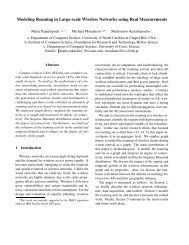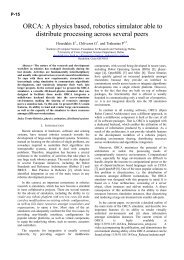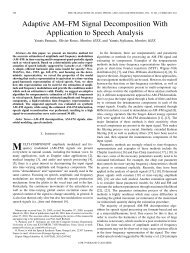Seven Degrees of Separation in Mobile Ad Hoc Networks - ICS
Seven Degrees of Separation in Mobile Ad Hoc Networks - ICS
Seven Degrees of Separation in Mobile Ad Hoc Networks - ICS
Create successful ePaper yourself
Turn your PDF publications into a flip-book with our unique Google optimized e-Paper software.
for a population size <strong>of</strong> 17 users 2 . Our simulations show<br />
that the ad hoc networks can be very effective <strong>in</strong> distribut<strong>in</strong>g<br />
popular <strong>in</strong>formation.<br />
The rema<strong>in</strong>der <strong>of</strong> this paper is organized as follows. Section<br />
II-A gives an overview <strong>of</strong> the <strong>in</strong>frastructure and the ma<strong>in</strong><br />
components <strong>of</strong> 7DS. Section II-B presents simulation results<br />
and Section II-C describes a simple epidemic model <strong>of</strong> data<br />
propagation with analytical and simulation results. Then, <strong>in</strong><br />
Section III, we discuss related work. F<strong>in</strong>ally, we frame our<br />
future efforts <strong>in</strong> Section IV.<br />
II. DATA SHARING<br />
A. Overview <strong>of</strong> the Architecture<br />
A mobile host may also communicate with other mobiles <strong>in</strong><br />
close proximity via a wireless LAN. We assume a well known<br />
multicast address <strong>in</strong> which the cooperat<strong>in</strong>g mobiles may listen<br />
and send requests and responses. The data shar<strong>in</strong>g can be<br />
pull or push-based. For the pull based, a 7DS client <strong>in</strong>itiates<br />
a query to the multicast group. For the push mechanism, a<br />
7DS client broadcasts an <strong>in</strong>dex <strong>of</strong> the publicly accessible content<br />
<strong>of</strong> its cache to the multicast group. The <strong>in</strong>dex is a highly<br />
structured description (summary) <strong>of</strong> the cache and may <strong>in</strong>clude<br />
URLs, and pairs <strong>of</strong> attribute names with their values.<br />
Apart from the query client, each device may run a m<strong>in</strong>iature<br />
server that consists <strong>of</strong> a cache manager, a response mechanism<br />
and/or a publish<strong>in</strong>g mechanism.<br />
The cache manager is <strong>in</strong> charge <strong>of</strong> organiz<strong>in</strong>g the local<br />
cache and search<strong>in</strong>g the data. The cache size may vary for different<br />
devices. Each device ma<strong>in</strong>ta<strong>in</strong>s a cache conta<strong>in</strong><strong>in</strong>g <strong>in</strong>formation<br />
items received from other 7DS participants. Cache<br />
items are marked up with application-specific attributes and<br />
support attribute-match<strong>in</strong>g searches. These attributes are embedded<br />
<strong>in</strong> queries. Pull-based clients broadcast queries periodically<br />
till they receive the data. We def<strong>in</strong>e the query <strong>in</strong>terval<br />
as the time that lapses between two consecutive queries sent<br />
by the same client.<br />
As we mention, each 7DS may act as client-querier and/or<br />
server. It periodically checks the queries it received. For each<br />
query, it extracts the attributes, performs a lookup and sends<br />
the response (if any) to the group. The server may <strong>in</strong>clude<br />
some additional <strong>in</strong>formation, e.g., size <strong>of</strong> a web page that<br />
corresponds to that URL, encryption methods, media format.<br />
To reduce the traffic at each device, clients may specify dynamically<br />
a new multicast group to receive the responses, so<br />
only <strong>in</strong>terested devices receive the data (up to the application<br />
layer). Based on their pr<strong>of</strong>ile, receivers filter and cache these<br />
<strong>in</strong>dices locally for brows<strong>in</strong>g.<br />
The system can set up a time <strong>in</strong>terval (i.e., “collaboration<br />
time”) dur<strong>in</strong>g which it receives queries, responds to requests,<br />
advertises its <strong>in</strong>dex. After that the mobile switches the network<br />
<strong>in</strong>terface <strong>in</strong>to a low power sleep state. The mobile may<br />
alternate “sleep” and “collaborat<strong>in</strong>g” states with duration that<br />
depends on the collaboration policy, battery level and power<br />
In this case the <strong>in</strong>terarrival time at each stop is 180s.<br />
constra<strong>in</strong>ts 3 . S<strong>in</strong>ce the idl<strong>in</strong>g cost <strong>of</strong> the network <strong>in</strong>terface is<br />
a major power consumer [5], the above policy can be used as<br />
a power sav<strong>in</strong>g mechanism.<br />
B. Simulation Results<br />
In this section we quantify how fast <strong>in</strong>formation spreads<br />
among users mov<strong>in</strong>g accord<strong>in</strong>g to the random waypo<strong>in</strong>t and<br />
the subway model. In addition, <strong>in</strong> the Section II-C we analyze<br />
and simulate an environment where <strong>in</strong>formation propagates<br />
accord<strong>in</strong>g to a simple epidemic model. We use the ns-2 simulator<br />
[6] with the mobility and wireless extensions [7]. In all<br />
cases, we compute the number <strong>of</strong> users that have the <strong>in</strong>formation<br />
after a period <strong>of</strong> time, the average delay until the user<br />
receives the <strong>in</strong>formation, and the average time until all users<br />
acquire the data. The wireless LAN is modeled as a Wave-<br />
LAN network <strong>in</strong>terface 4 .<br />
We consider a rather simple, pull-based communication<br />
protocol: When a user arrives <strong>in</strong> the system (e.g., on a platform<br />
<strong>of</strong> a station for the subway model), if it is not already<br />
a data holder, it starts periodically broadcast<strong>in</strong>g a query until<br />
it receives it. When a data holder gets a query, it responds<br />
by broadcast<strong>in</strong>g the data. Due to the broadcast<strong>in</strong>g channel,<br />
not only the mobile who queried, but also the devices <strong>in</strong> close<br />
proximity will receive the data.<br />
In both models, we assume that at the beg<strong>in</strong>n<strong>in</strong>g, there is<br />
only one data holder and the rest are queriers. The data holder<br />
is uniformly chosen from all users. For simplicity <strong>of</strong> exposition,<br />
we fix the data object and assume that all users are<br />
<strong>in</strong>terested <strong>in</strong> it.<br />
Random Way Model<br />
We consider nodes mov<strong>in</strong>g <strong>in</strong> a 900 m x 900 m grid accord<strong>in</strong>g<br />
to random waypo<strong>in</strong>t mobility model [4]. The random waypo<strong>in</strong>t<br />
model breaks the entire movement <strong>of</strong> a mobile host <strong>in</strong>to<br />
alternat<strong>in</strong>g motion and rest periods. A mobile host first stays<br />
at a location for a certa<strong>in</strong> time, then it moves to a new randomly<br />
chosen dest<strong>in</strong>ation at a speed drawn uniformly from<br />
a given <strong>in</strong>terval. In the random waypo<strong>in</strong>t, each node starts<br />
from a position , and is mov<strong>in</strong>g towards a dest<strong>in</strong>ation<br />
po<strong>in</strong>t . For each node, the and ¡£¢¥¤§¦©¨¤ are uniformly<br />
selected from ¡¢©¦¨§ ¢ ¤ ¦©¨ ¦<br />
¤ ¦©¢ ¨§ . Each node is mov<strong>in</strong>g to its dest<strong>in</strong>ation<br />
with a speed uniformly selected from (0 m/s, 1.5 m/s).<br />
When a mobile reaches its dest<strong>in</strong>ation, it pauses for a fixed<br />
amount <strong>of</strong> time, then chooses a new dest<strong>in</strong>ation and speed (as<br />
<strong>in</strong> the previous step) and cont<strong>in</strong>ues mov<strong>in</strong>g. We fix the pause<br />
time to be 50 s and the maximum speed, 1.5 m/s. We run a<br />
set <strong>of</strong> 100 tests, each for 1500 s for every pair <strong>of</strong> population<br />
sizes (5, 10, 25, 50) and query <strong>in</strong>terval (1.5 s, 15 s, 60 s, 120 s,<br />
180 s). The number <strong>of</strong> data holders at the end <strong>of</strong> each experiment<br />
is above 86%.<br />
Fig. 1 illustrates the average delay for a mobile host until it<br />
It can take place <strong>in</strong> a semi-automated way via a user <strong>in</strong>terface <strong>in</strong> which<br />
the system displays the battery level when is below a threshold, and can also<br />
illustrate the degree <strong>of</strong> collaboration dur<strong>in</strong>g an <strong>in</strong>terval <strong>of</strong> <br />
time.<br />
We used the WaveLAN <strong>in</strong>terface simulation available with the ns-2 s<strong>of</strong>tware.
















